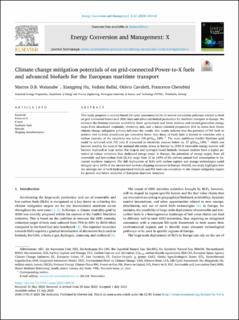| dc.contributor.author | Watanabe, Marcos Djun Barbosa | |
| dc.contributor.author | Hu, Xiangping | |
| dc.contributor.author | Ballal, Vedant Pushpahas | |
| dc.contributor.author | Cavalett, Otavio | |
| dc.contributor.author | Cherubini, Francesco | |
| dc.date.accessioned | 2023-08-29T13:19:32Z | |
| dc.date.available | 2023-08-29T13:19:32Z | |
| dc.date.created | 2023-08-16T13:26:58Z | |
| dc.date.issued | 2023 | |
| dc.identifier.citation | Energy Conversion and Management: X. 2023, 20 . | en_US |
| dc.identifier.uri | https://hdl.handle.net/11250/3086236 | |
| dc.description.abstract | This study proposes a country-based life-cycle assessment (LCA) of several conversion pathways related to both on grid-connected Power-to-X (PtX) fuels and advanced biofuel production for maritime transport in Europe. We estimate the biomass resource availability (both agricultural and forest residues and second-generation energy crops from abandoned cropland), electricity mix, and a future-oriented prospective LCA to assess how future climate change mitigation policies influence the results. Our results indicate that the potential of PtX fuels to achieve well-to-wake greenhouse gas intensities lower than those of fossil fuels is limited to countries with a carbon intensity of the electricity mix below 100 gCO2eq kWh−1. The more ambitious FuelEU Maritime goal could be achieved with PtX only if connected to electricity sources below ca. 17 gCO2eq kWh−1 which can become possible for most of the national electricity mixes in Europe by 2050 if renewable energy sources will become deployed at large scales. For drop-in and hydrogen-based biofuels, biomass residues have a higher potential to reduce emissions than dedicated energy crops. In Europe, the potentials of energy supply from all renewable and low-carbon fuels (RLFs) range from 32 to 149% of the current annual fuel consumption in European maritime transport. The full deployment of RLFs with carbon capture and storage technologies could mitigate up to 184% of the current well-to-wake shipping emissions in Europe. Overall, our study highlights how the strategic use of both hydrogen-based biofuels and PtX fuels can contribute to the climate mitigation targets for present and future scenarios of European maritime transport. | en_US |
| dc.language.iso | eng | en_US |
| dc.publisher | Elsevier | en_US |
| dc.rights | Navngivelse 4.0 Internasjonal | * |
| dc.rights.uri | http://creativecommons.org/licenses/by/4.0/deed.no | * |
| dc.title | Climate change mitigation potentials of on grid-connected Power-to-X fuels and advanced biofuels for the European maritime transport | en_US |
| dc.title.alternative | Climate change mitigation potentials of on grid-connected Power-to-X fuels and advanced biofuels for the European maritime transport | en_US |
| dc.type | Peer reviewed | en_US |
| dc.type | Journal article | en_US |
| dc.description.version | publishedVersion | en_US |
| dc.source.pagenumber | 13 | en_US |
| dc.source.volume | 20 | en_US |
| dc.source.journal | Energy Conversion and Management: X | en_US |
| dc.identifier.doi | https://doi.org/10.1016/j.ecmx.2023.100418 | |
| dc.identifier.cristin | 2167360 | |
| dc.relation.project | Norges forskningsråd: 257622 | en_US |
| dc.relation.project | Norges forskningsråd: 288047 | en_US |
| dc.relation.project | Norges forskningsråd: 302276 | en_US |
| dc.relation.project | Norges forskningsråd: 333118 | en_US |
| cristin.ispublished | true | |
| cristin.fulltext | original | |
| cristin.qualitycode | 1 | |

